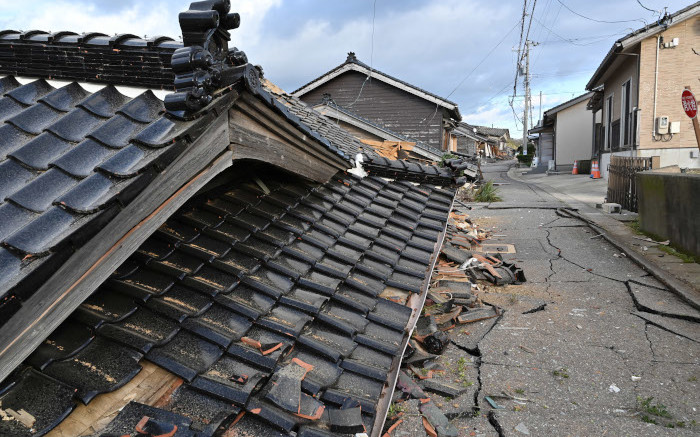
The work of thousands of rescue workers was hampered by bad weather, with snow forecast for Sunday – and roads destroyed by gaping cracks and blocked by an estimated 1,000 landslides.
Collapsed wooden houses are seen in Wajima, Ishikawa Prefecture, Jan. 2, 2024, a day after a powerful 7.5-magnitude earthquake struck the Noto region of Ishikawa Prefecture in the afternoon. Image: Kazuhiro NOGI/AFP
SHIROMARU – Rescuers and residents searched through the rubble on Saturday as their focus turned to recovering bodies and cleanup operations rather than searching for survivors, five days after a powerful earthquake struck central Japan, killing at least 126 people.
The death toll from the magnitude 7.5 quake on New Year’s Day in the Ishikawa region of Japan’s main island of Honshu is certain to rise. Authorities said 210 people were still missing.
The work of thousands of rescue workers was hampered by bad weather, with snow forecast for Sunday – and roads destroyed by gaping cracks and blocked by an estimated 1,000 landslides.
Two elderly women were rescued from the rubble of their homes in the hard-hit town of Wajima on the Noto Peninsula on Thursday, but there has been no cause for celebration since.
In Suzu, where dozens of houses lie in ruins, a dog barked on Friday while an AFP team filmed the cleanup effort – a sign of a grim discovery.
“Training for disaster rescue dogs begins with something similar to a game of hide-and-seek,” dog trainer Masayo Kikuchi told AFP.
“They are finally being taught to bark if they see a person under the rubble.”
Homes with discovered fatalities are marked and left alone until a coroner can come with relatives to identify the body.
Fishing boats were sunk by tsunami waves or lifted onto the shore like toys, with one person also reportedly swept away.
The coastal community of Shiromaru, hit by a meter-high tsunami on January 1, was a mess of wooden, metal and plastic debris.
“The tsunami came from Shiromaru Bay through the river and then ran up the street,” said Toshio Sakashita, one of about 100 residents.
“We have not received any public support here. Look, the main road is still blocked because of the rubble that has not been touched,” the 69-year-old told AFP.
“We can’t live in our house anymore,” Yukio Teraoka, 82, told AFP as he and his wife shoveled heavy, soaked sand brought by the waves from their destroyed home.
PRAY FOR SOULS
Local authorities announced on Saturday that 126 people were dead.
“We sincerely pray for the repose of the souls of the deceased,” Prime Minister Fumio Kishida said on social media.
In an emergency meeting, he urged ministers to repair roads “urgently and quickly” to help hundreds of people in cut-off areas.
Despite frosty relations with Japan, North Korean leader Kim Jong Un sent a message of “deep sympathy and condolences,” state news agency KCNA reported, echoing the United States, China and other countries.
In Ishikawa, around 23,200 households were without electricity and more than 66,400 were without running water.
Power and water outages also affected hospitals and facilities for the care of the elderly and disabled.
“We are facing extremely serious situations,” Ishikawa Gov. Hiroshi Hase said during a disaster management meeting due to the water outage.
Restoring running water will take a long time “as many water pipes have cracks,” he said.
More than 30,000 people were in 366 government shelters.
Japan experiences hundreds of earthquakes every year, most of which cause no damage because of strict building regulations that have been in place for more than four decades. But many buildings are older.
The country is hit by the devastating 2011 earthquake, which triggered a tsunami, left around 18,500 people dead or missing and caused a nuclear disaster at the Fukushima nuclear power plant.






Recent Comments